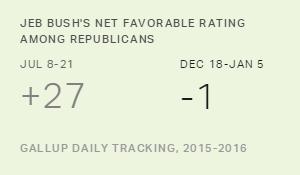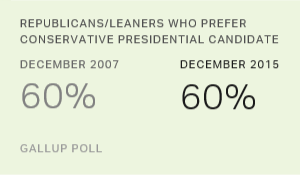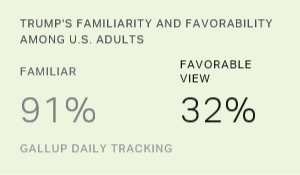Story Highlights
- Bush's net favorable rating among Republicans has dropped since July
- Bush has lost more ground than any other major candidate
- Bush now has the worst image among Republicans of any GOP candidate
PRINCETON, N.J. -- Former Florida Gov. Jeb Bush's image among Republicans has steadily worsened over the past 5 ½ months. His current net favorable rating of -1 (44% favorable, 45% unfavorable) among Republicans is significantly lower than his +27 (54% favorable, 27% unfavorable) rating in mid-July.
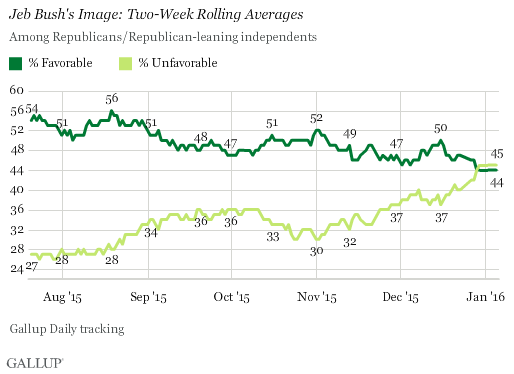
Bush's overall familiarity among Republicans -- defined as the percentage who know him well enough to rate him either positively or negatively -- was already high (81%) when Gallup began tracking the candidate images in mid-July. That score has since edged upward, to 89%, second only to Donald Trump's 94% among the major GOP candidates.
But Bush's campaign efforts since July have clearly moved his image in a negative direction. The percentage of Republicans with a favorable opinion of Bush has dropped 10 percentage points, while the percentage with an unfavorable opinion has increased 18 points.
On a relative basis, Bush's current -1 net favorable rating among Republicans and Republican-leaning independents is the worst of any major GOP candidate -- lower than John Kasich's +5, and well below seven other GOP candidates Gallup is tracking. Ted Cruz is at the top of the list in the latest two-week period, from Dec. 18-Jan. 5, with a net favorable rating of +45, followed by Ben Carson at +40, Marco Rubio at +35 and Mike Huckabee at +33. Carly Fiorina, Donald Trump and Chris Christie all have net favorable ratings in the +23 to +25 range. Although Bush is least popular among Republicans, Trump has the lowest net favorable score among all U.S. adults, -26, compared with -13 for Bush.
The net favorable rating among Republicans and Republican-leaning independents is the difference between the percentage who have a favorable opinion and the percentage who have an unfavorable opinion of each candidate. Bush not only has the lowest net favorable rating among this group, but his current unfavorable percentage of 45% is significantly higher than for any of these other candidates -- 10 points higher than Trump's, who is second to the bottom on this metric. Cruz, by contrast, is viewed unfavorably by only 16% of Republicans.
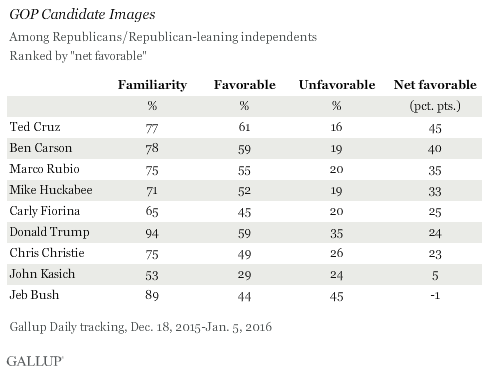
Bush Loses Most Ground Among Republican Men
Bush's net favorable rating among men has dropped 39 points since July, compared with a 13-point drop among women. Bush's image showed only a modest five-point gender gap in July, but it is now 26 points.
As is the case for most GOP candidates, Bush does better among conservative than among moderate/liberal Republicans, yet his image has dropped roughly the same amount among both groups. Bush remains more popular among older Republicans than among those who are younger, and he has lost less ground since July among those 55 and older than among those aged 18 to 54.
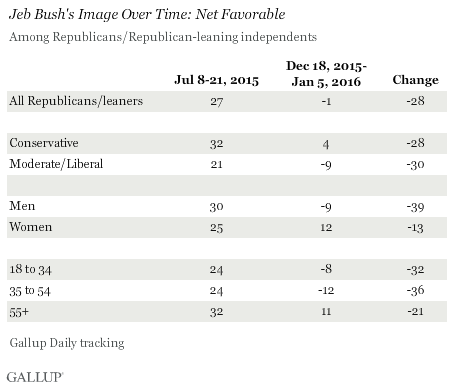
Bush and Christie Follow Opposite Paths
Although New Jersey Gov. Chris Christie's image is still below average for GOP candidates, it is much better than it was in July. Overall, Christie has gained more in net favorability than any other candidate since then, while Bush has lost the most -- essentially the opposite trajectories.
Christie is the only major GOP candidate other than Bush whose net favorable rating among Republicans has dipped below zero, reaching -2 in late July/early August. But Christie's image has steadily improved since then, and is now +23. Bush's image has nosedived from +27 in mid-July to -1 over the same period.
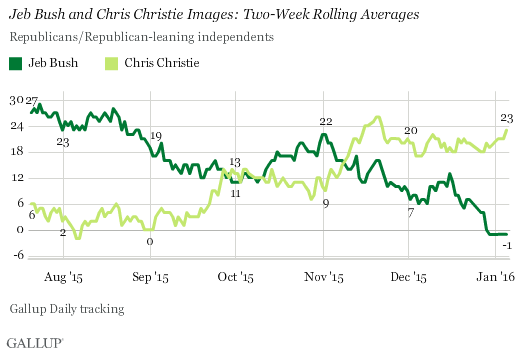
Implications
Bush's image among Republicans has grown steadily more negative with each passing month since July, and he now enters the 2016 election year with the worst image of any of nine major GOP candidates among the party base -- a trend that is presumably the exact opposite of what his campaign would have wanted.
There have been no highly publicized incidents, scandals or revelations connected with Bush's campaign since July, and thus no single factor can easily be identified as the culprit for his sharply deteriorated image. His current negative image is all the more intriguing given his extraordinary family connection to two living ex-presidents. One problem for Bush may be that in this "anti-establishment year," Republicans may see his family heritage as more of a negative than a positive.
Bush's negative image could merely reflect his lack of momentum in the campaign, including disappointing reviews of his debate performance and his struggle to gain traction in voter preference polls. Many political pundits considered him the front-runner going into the campaign season, given his high name recognition and huge fundraising advantages, but so far neither has helped him to gain GOP voters' loyalties. Much of that could be the mood of the party base, which has led to the rise of anti-establishment figures such as Trump, Carson and Cruz. In contrast, as noted, no candidate is probably more strongly linked to the party establishment and the past than Bush.
These data are available in Gallup Analytics.
Survey Methods
Results for this Gallup poll are based on telephone interviews conducted July 8, 2015-Jan. 5, 2016, on the Gallup U.S. Daily survey, with a random sample of 44,111 Republicans and Republican-leaning independents, aged 18 and older, living in all 50 U.S. states and the District of Columbia. Each candidate was rated by a random subset of respondents during this period, with the sample sizes rating each candidate averaging between 800 and 1,000 Republicans and Republican-leaning independents within each two-week interviewing period.
For results based on the total sample of Republicans and Republican-leaning independents, aged 18 and older, rating each candidate at each time period, the margin of sampling error is ±4 percentage points at the 95% confidence level. All reported margins of sampling error include computed design effects for weighting.
Each sample of national adults includes a minimum quota of 50% cellphone respondents and 50% landline respondents, with additional minimum quotas by time zone within region. Landline and cellular telephone numbers are selected using random-digit-dial methods.
Learn more about how the Gallup U.S. Daily works.
